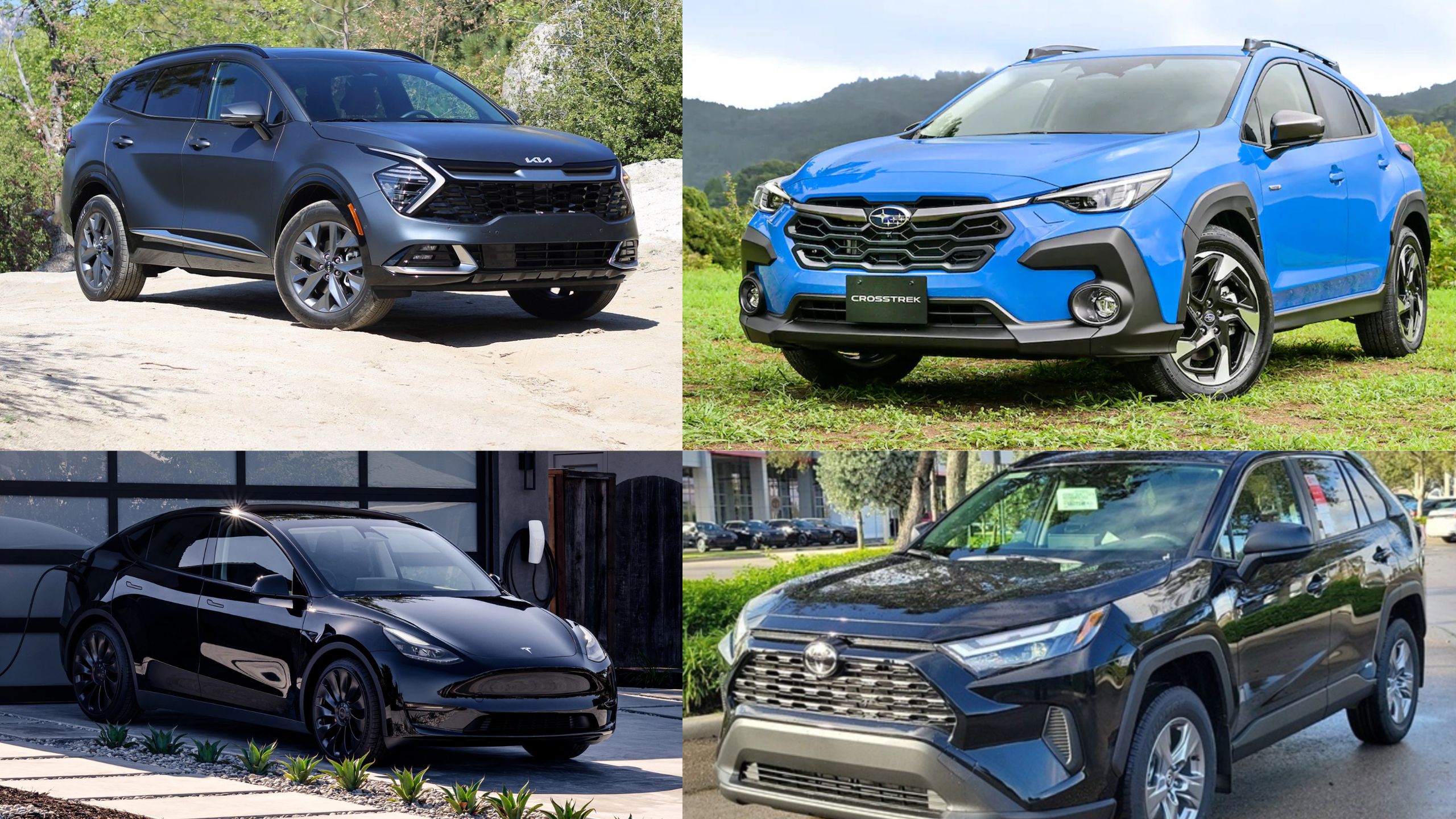The automotive world has evolved dramatically in recent years, with manufacturers striving to balance power and efficiency in all-wheel drive vehicles.
Today’s car buyers no longer need to choose between capability and fuel economy, as engineering innovations have produced AWD systems that deliver impressive performance without sacrificing efficiency.
At the same time, some manufacturers continue to prioritize raw power in their AWD offerings, creating vehicles that emphasize performance over fuel economy.
This dichotomy represents two distinct philosophies in automotive design, catering to different consumer priorities and driving conditions. For those living in regions with challenging weather or rugged terrain, an efficient AWD vehicle can provide necessary traction and capability while keeping fuel costs manageable.
Conversely, performance enthusiasts seeking the exhilaration of powerful acceleration and handling may willingly accept higher fuel consumption as a trade-off.
This article examines five AWD vehicles that expertly balance efficiency with capability, followed by five models that unapologetically prioritize power at the expense of fuel economy, helping consumers understand where different models fall on this spectrum and which might best suit their needs and preferences.
5 Efficient AWD Cars
Modern engineering has finally conquered the challenge of combining all-wheel drive capability with impressive fuel economy in these five standout vehicles.
These AWD models prove you don’t need to sacrifice efficiency for sure-footed performance in all weather conditions and terrains. Experience confidence-inspiring traction and handling without the traditional penalty at the pump that AWD systems once demanded.
1. Toyota RAV4 Hybrid AWD
The Toyota RAV4 Hybrid stands as a testament to Toyota’s mastery of hybrid technology, offering a compelling blend of efficiency and all-weather capability.
This compact SUV employs a sophisticated Electronic On-Demand AWD system that pairs a 2.5-liter four-cylinder engine with electric motors, one at the front and another dedicated to powering the rear wheels when needed.
This intelligent setup allows the RAV4 Hybrid to achieve an impressive EPA-estimated 41 mpg in city driving and 38 mpg on highways, figures that would have seemed impossible for an AWD vehicle just a decade ago.
What makes the RAV4 Hybrid particularly noteworthy is how seamlessly it transitions between front-wheel drive in normal conditions to all-wheel drive when sensors detect slippage or during acceleration.
The rear electric motor engages instantly, providing immediate torque to the rear wheels without the mechanical complexity and weight of traditional AWD systems. This translates to confident handling in inclement weather and light off-road conditions without the typical fuel economy penalties.
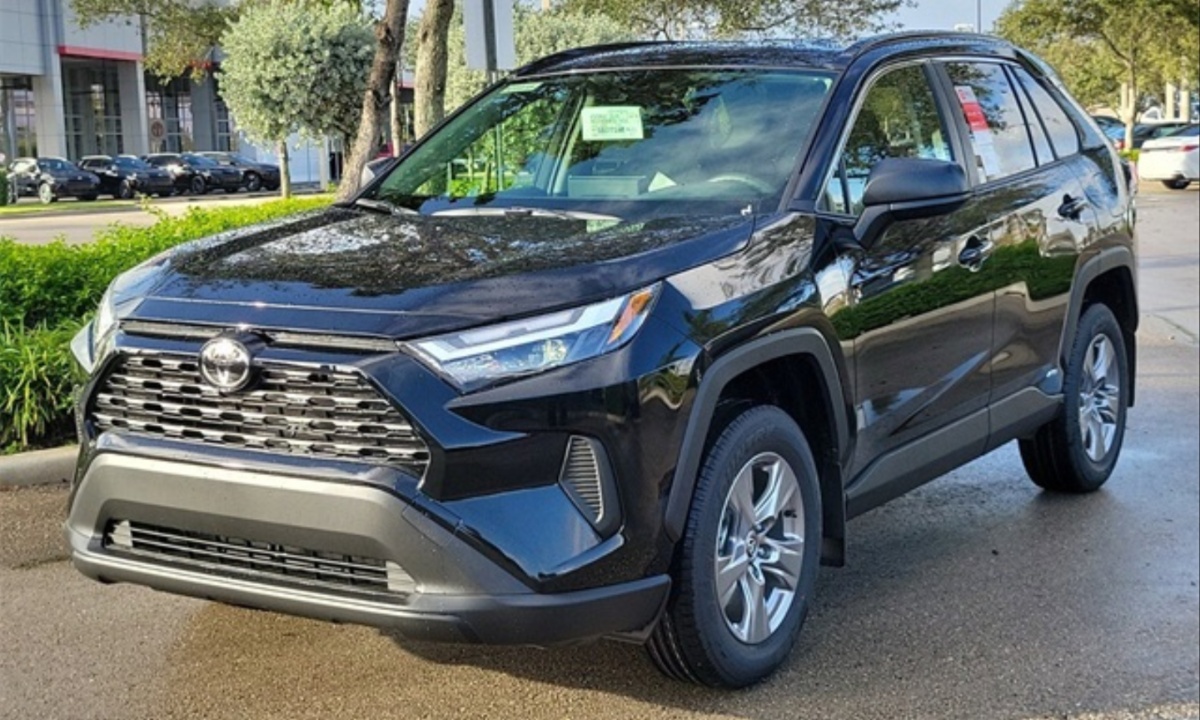
The vehicle’s Predictive Efficient Drive system further enhances efficiency by learning driver patterns and optimizing hybrid operation accordingly.
When descending hills or approaching stops, the system intelligently captures regenerative braking energy, storing it in the battery for later use. With 219 combined horsepower, the RAV4 Hybrid delivers respectable acceleration (0-60 mph in around 7.4 seconds) while maintaining its excellent fuel economy.
Interior accommodations remain practical and spacious, with 37.6 cubic feet of cargo space behind the rear seats that expands to 69.8 cubic feet with seats folded.
Toyota’s Safety Sense 2.0 suite comes standard, including adaptive cruise control, lane-keeping assist, and automatic emergency braking. With a starting price in the mid-$30,000 range, the RAV4 Hybrid AWD proves that efficiency, capability, and value can coexist in a single, well-designed package.
2. Subaru Crosstrek Hybrid
The Subaru Crosstrek Hybrid represents a thoughtful evolution of Subaru’s legendary symmetrical all-wheel drive system, enhanced with plug-in hybrid technology.
Unlike many competitors that offer AWD as an option or with limited capability, the Crosstrek Hybrid maintains Subaru’s commitment to full-time AWD while achieving an EPA-estimated 90 MPGe in hybrid mode and 35 mpg combined when operating as a conventional hybrid after the electric charge is depleted.
What sets the Crosstrek Hybrid apart is its ability to travel up to 17 miles on pure electric power, enough to cover many daily commutes without using a drop of gasoline.
When both power sources work together, the 2.0-liter boxer engine and electric motor produce a combined 148 horsepower that feels more responsive than the numbers suggest, thanks to the immediate torque delivery from the electric motor.
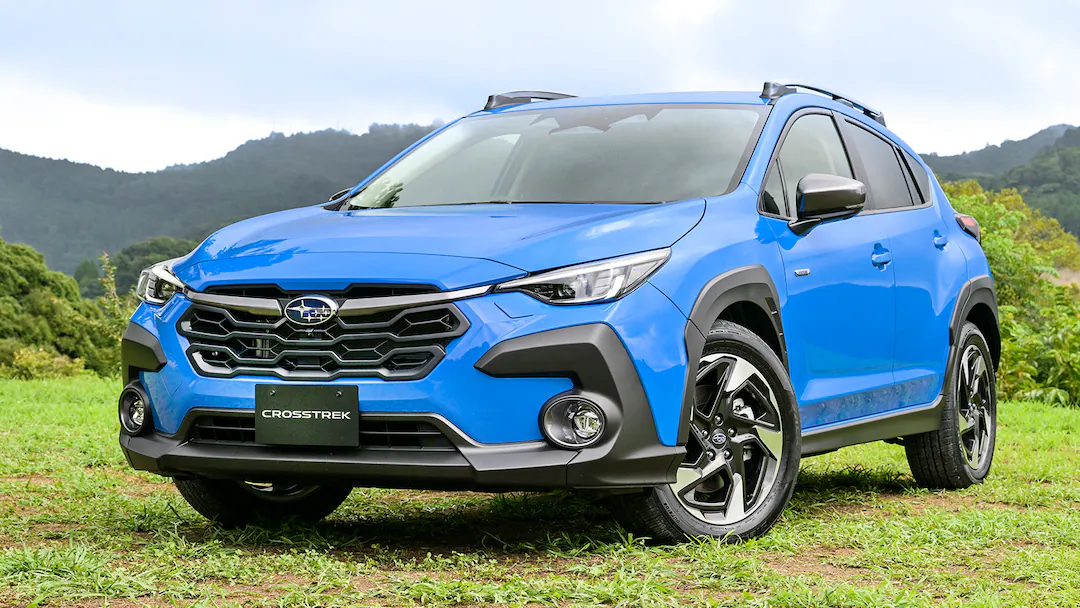
Subaru’s symmetrical AWD system distributes power to all four wheels continuously, adjusting torque distribution as needed for optimal traction.
This provides a significant advantage in snowy or muddy conditions compared to on-demand AWD systems that primarily operate in front-wheel drive until slippage is detected.
With 8.7 inches of ground clearance unchanged from the non-hybrid model, the Crosstrek Hybrid maintains impressive off-road capability despite carrying the additional weight of its battery pack.
The vehicle features X-MODE, a sophisticated traction management system that optimizes the AWD system for challenging conditions by controlling engine output, transmission gear ratio, AWD torque split, and braking to maximize grip on slippery surfaces.
Inside, the cabin offers comfortable accommodations for five passengers, though cargo space is somewhat reduced compared to the standard Crosstrek due to the battery placement.
While the Crosstrek Hybrid commands a premium price (starting around $36,000 before federal and state incentives), its combination of Subaru’s proven AWD capability with modern plug-in hybrid efficiency makes it an excellent choice for environmentally conscious drivers who require genuine all-weather performance.
3. Tesla Model Y Long Range AWD
The Tesla Model Y Long Range AWD exemplifies how electric propulsion can revolutionize our understanding of efficient all-wheel drive systems.
Unlike traditional combustion engine vehicles that require complex mechanical linkages to distribute power, the Model Y employs dual electric motors, one at each axle, that can instantaneously and precisely control torque delivery to all four wheels with remarkable efficiency.
This elegant solution helps the Model Y achieve an EPA-estimated range of 330 miles while delivering performance that rivals many sports cars. The Model Y’s efficiency stems from several factors beyond its electric powertrain.
Tesla’s industry-leading battery and motor technology operate at approximately 90% efficiency, compared to roughly 40% for the most efficient internal combustion engines.
The vehicle’s sleek aerodynamic design, with a drag coefficient of just 0.23, minimizes energy waste at highway speeds. Regenerative braking recaptures kinetic energy during deceleration, returning it to the battery rather than dissipating it as heat through brake pads.
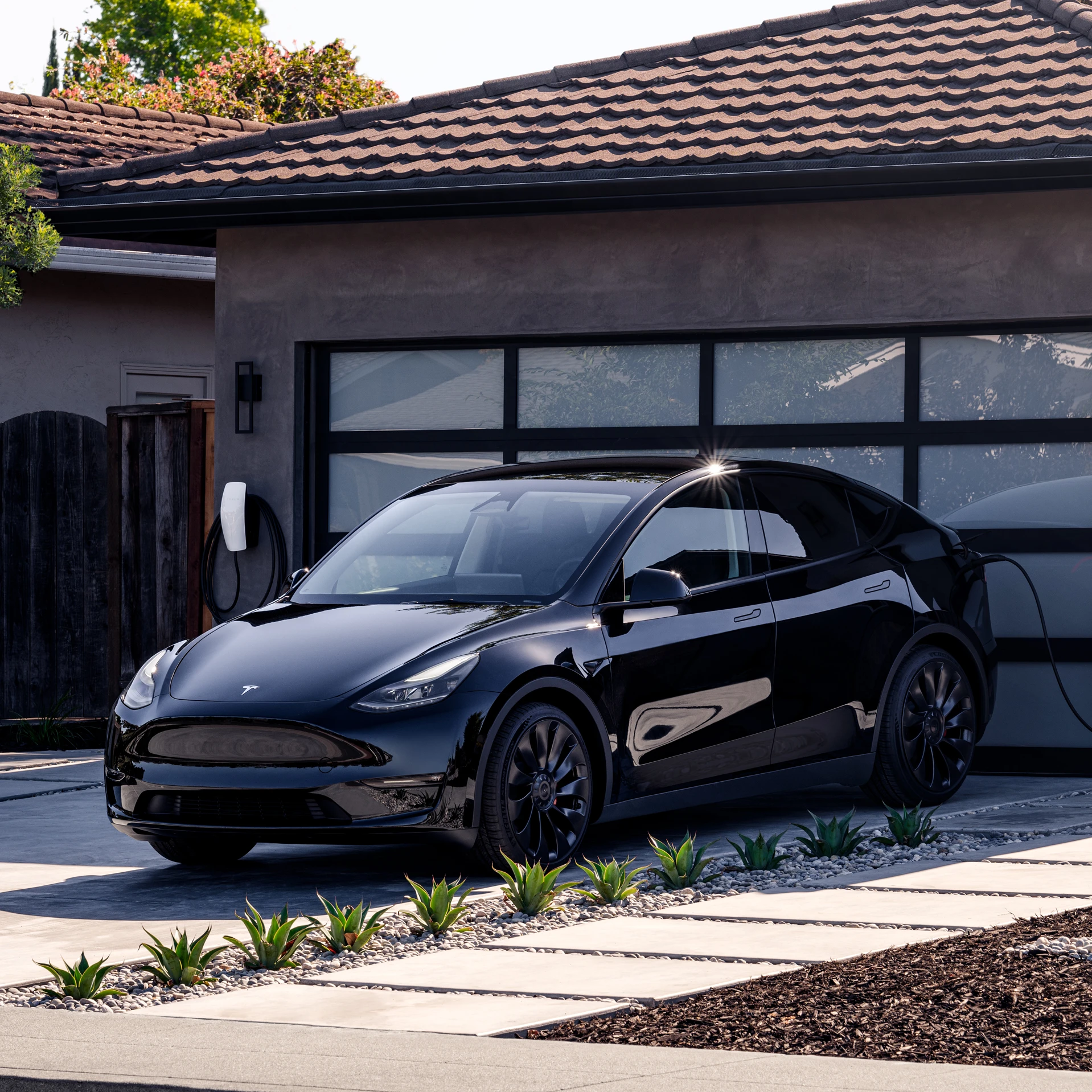
Despite its efficiency focus, the Model Y’s performance credentials are impressive. Its dual motors generate a combined output of 384 horsepower, propelling the crossover from 0-60 mph in just 4.8 seconds.
The low center of gravity created by the floor-mounted battery pack enhances handling dynamics, while the precise torque vectoring capabilities of the dual-motor setup provide exceptional stability in corners and adverse conditions.
The all-wheel drive system excels in winter driving, with the ability to make thousands of adjustments per second to optimize traction on snow and ice. Tesla’s over-the-air update capability means the AWD system continually improves over time as the company refines its traction control algorithms.
Inside, the Model Y offers a minimalist interior dominated by a 15-inch touchscreen that controls nearly all vehicle functions. With up to 76 cubic feet of cargo space with the rear seats folded and an additional front trunk, the Model Y combines efficiency with remarkable practicality.
While it’s approximately $54,000 starting price positions it as a premium offering, federal and state incentives, combined with significant savings on fuel and maintenance costs, improve its long-term value proposition for buyers seeking efficient AWD transportation.
4. Kia Sportage Hybrid AWD
The Kia Sportage Hybrid AWD represents one of the newest and most compelling entries in the efficient all-wheel drive segment.
Completely redesigned for its latest generation, the Sportage Hybrid combines distinctive styling with a sophisticated hybrid powertrain that delivers an impressive EPA-estimated 38 mpg combined in AWD configuration, a figure that puts it among the most efficient compact SUVs with all-wheel drive capability.
Kia engineers have created an intelligent AWD system specifically optimized for a hybrid application. The setup employs a 1.6-liter turbocharged four-cylinder engine working in concert with a 44-kilowatt electric motor and a 1.49-kWh lithium-ion battery, producing a combined 227 horsepower and 258 lb-ft of torque.
This power flows through a conventional six-speed automatic transmission rather than a continuously variable transmission (CVT) found in many hybrids, providing a more natural acceleration feel and improved towing capacity.
The Sportage Hybrid’s AWD system includes a center locking differential and terrain-specific drive modes for optimizing performance in snow, mud, and sand.
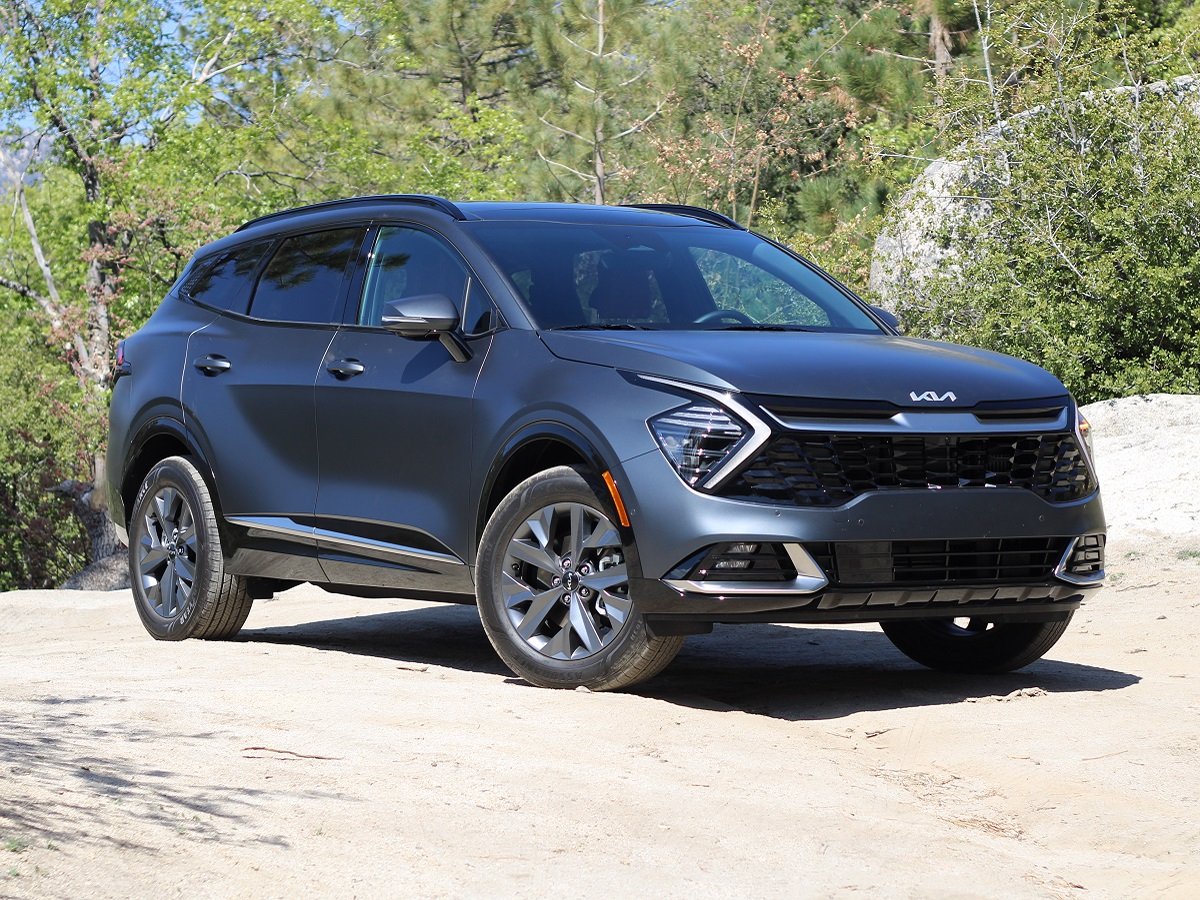
What makes this system particularly efficient is its ability to completely disconnect the rear driveshaft when additional traction isn’t needed, eliminating the parasitic losses associated with constantly rotating AWD components.
When sensors detect slippage or the driver selects a specific terrain mode, the system can instantly engage all four wheels to provide enhanced stability and traction.
Inside, the Sportage Hybrid offers a tech-forward experience with an available dual 12.3-inch panoramic display system that combines a digital instrument cluster with an infotainment touchscreen.
The cabin provides generous space for passengers with 39.5 inches of rear legroom more than many competitors in its class. Cargo capacity is similarly impressive at 39.5 cubic feet behind the rear seats, expanding to 74.1 cubic feet with the seats folded.
With a starting price around $28,000 for the base LX AWD model (ranging to about $37,000 for the top-tier SX-Prestige AWD), the Sportage Hybrid represents an excellent value proposition for buyers seeking an efficient all-wheel drive vehicle without the premium pricing of some competitors.
Its combination of efficiency, practicality, and comprehensive warranty coverage makes it a standout option in an increasingly competitive segment.
Also Read: 5 Reliable Work Vehicles and 5 That Fail on the Job
5. Ford Maverick Hybrid AWD
The Ford Maverick Hybrid AWD represents a groundbreaking approach to efficient all-wheel drive capability in the rapidly expanding compact pickup segment.
Ford engineers have accomplished something remarkable with this vehicle: creating the first hybrid pickup with all-wheel drive capability that achieves an EPA-estimated 37 mpg combined an extraordinary figure for any AWD vehicle, let alone one with the utility of a truck bed.
The Maverick’s hybrid powertrain pairs a 2.5-liter Atkinson-cycle four-cylinder engine with an electric motor and a modest 1.1-kWh battery, generating a combined 191 horsepower.
Unlike conventional AWD systems that use a driveshaft to transfer power from the engine to the rear wheels, the Maverick Hybrid AWD employs a clever solution: the front wheels are powered by the hybrid system, while a separate electric motor drives the rear axle independently.
This allows the vehicle to operate in front-wheel drive mode during normal driving conditions for maximum efficiency, then seamlessly engage the rear wheels when additional traction is needed.
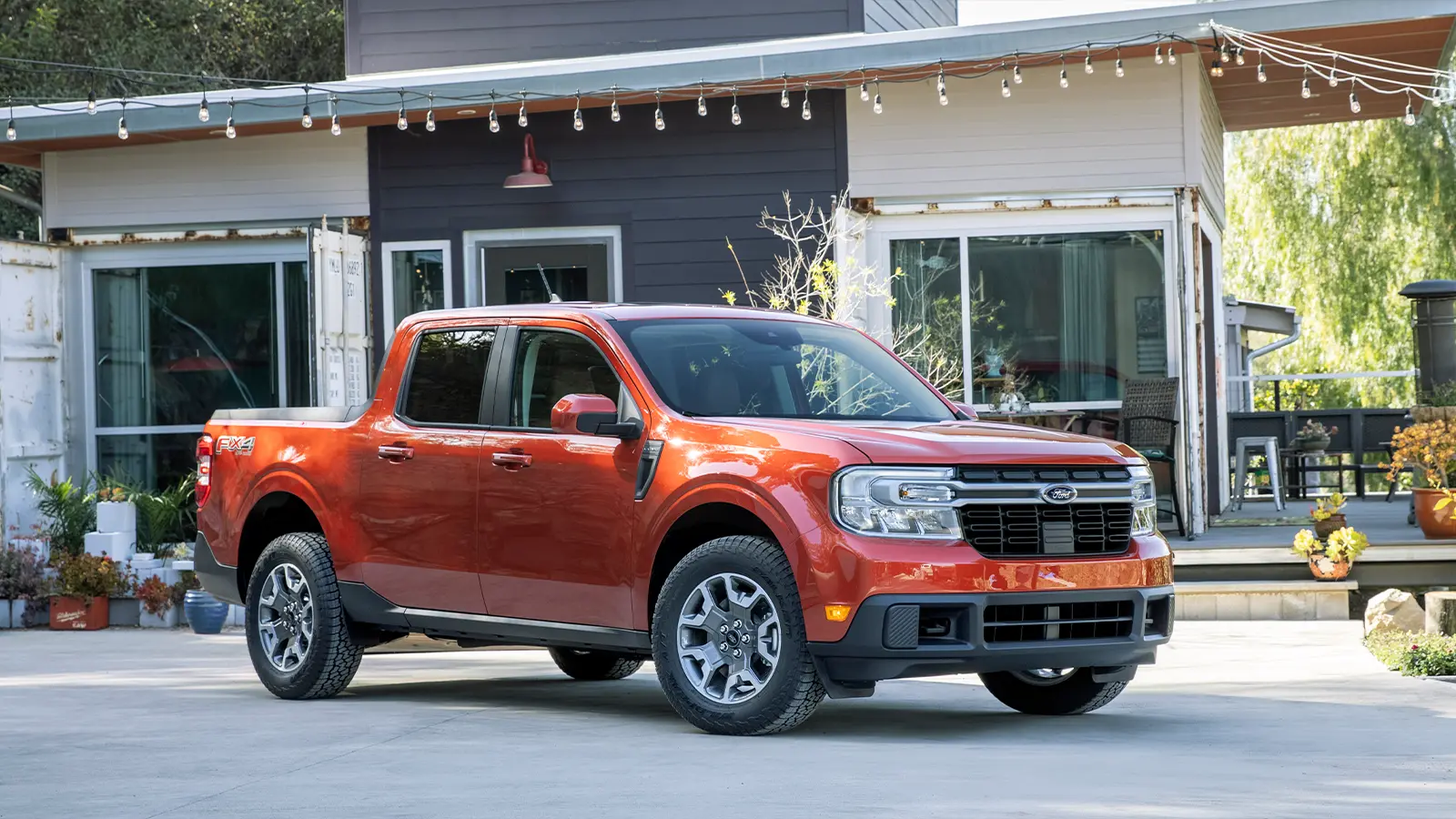
This system, similar to that found in the Maverick’s cousin, the Escape Hybrid AWD, provides several efficiency advantages. There’s no mechanical connection between the front and rear axles, eliminating the weight and friction losses of a traditional driveshaft.
The electric rear drive can provide instant torque exactly when and where it’s needed without waiting for mechanical systems to engage. The system even enables precise torque vectoring between the rear wheels for enhanced stability in slippery conditions.
Despite its efficient nature, the Maverick Hybrid AWD doesn’t sacrifice utility. It offers a 1,500-pound payload capacity and can tow up to 2,000 pounds, sufficient for many weekend warriors’ needs. The 4.5-foot bed includes Ford’s innovative FlexBed system with multiple tie-downs, power outlets, and customizable storage solutions.
The interior showcases clever use of space and materials, with durable fabrics and plastics designed for work-truck durability while maintaining commuter comfort. Standard features include an 8-inch touchscreen with Apple CarPlay and Android Auto compatibility.
With a starting price around $25,000 for AWD hybrid models, the Maverick offers exceptional value, especially considering its class-leading efficiency.
This combination of affordable pricing, impressive fuel economy, and genuine utility has made the Maverick one of the most in-demand vehicles in Ford’s lineup, often with waiting lists at dealerships, proof that efficient AWD vehicles can appeal to traditional truck buyers when thoughtfully executed.
5 AWD Cars That Trade Power for MPG
These five all-wheel drive models prioritize fuel efficiency over raw performance, delivering remarkable gas mileage while still maintaining the traction benefits of AWD.
For drivers seeking practical transportation rather than thrilling acceleration, these vehicles represent the perfect balance of economy and all-weather capability.
While they won’t win many drag races, these sensible AWD options will significantly reduce your visits to the gas station without sacrificing the security of four-wheel traction.
1. Dodge Challenger GT AWD
The Dodge Challenger GT AWD unapologetically embraces America’s muscle car heritage while adding all-weather capability through its sophisticated all-wheel drive system. Unlike most vehicles in this category that have gradually shifted toward enhancing efficiency, the Challenger GT firmly prioritizes brute force and driving excitement over fuel economy.
With an EPA-estimated rating of just 18 mpg city and 27 mpg highway, the Challenger GT certainly isn’t winning any green awards, but that’s hardly the point of this performance-focused machine.
Under the hood resides a naturally aspirated 3.6-liter Pentastar V6 engine producing 303 horsepower and 268 lb-ft of torque. While this is actually the most efficient engine offered in the Challenger lineup (the V8 options are significantly thirstier), it’s tuned for performance rather than economy.
The engine pairs with an 8-speed TorqueFlite automatic transmission that balances reasonable cruising efficiency with rapid downshifts when power is demanded. The transmission features Sport mode and paddle shifters for drivers who want more control over the powerband.
The AWD system in the Challenger GT is derived from the Charger police pursuit vehicle, designed to handle demanding conditions with authority.
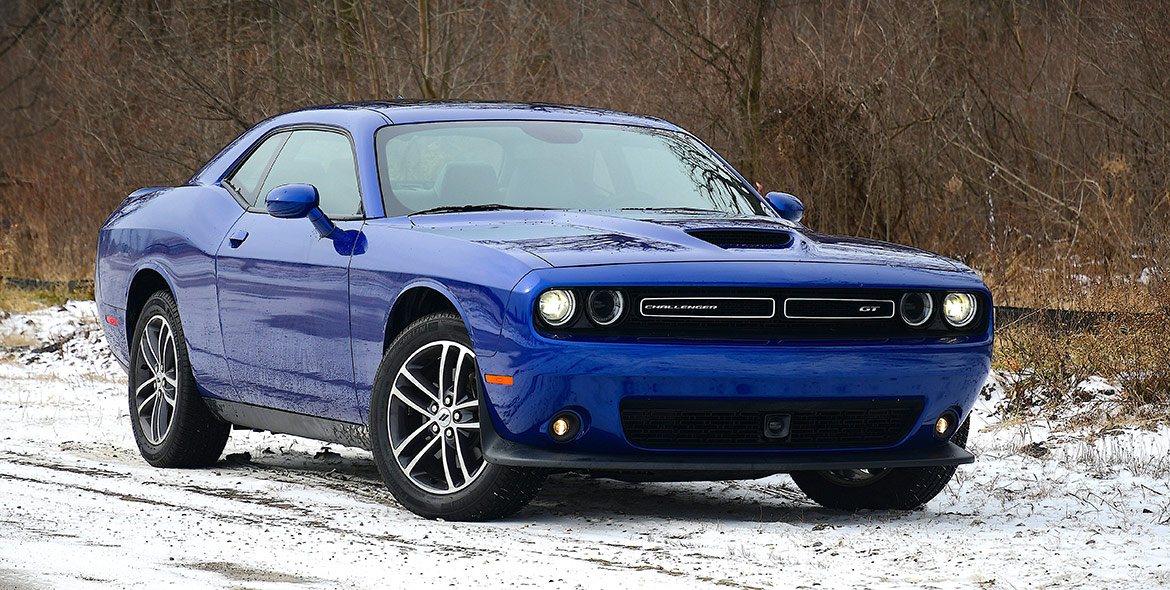
Unlike efficiency-focused AWD systems that primarily operate in front-wheel drive mode, the Challenger’s system actively engages all four wheels in most driving situations.
It can disconnect the front axle when appropriate to reduce drivetrain drag, but the system primarily focuses on maximizing grip and performance rather than minimizing fuel consumption.
Inside, the Challenger GT offers a blend of modern technology and retro styling cues that evoke the muscle car era. The Performance Pages feature in the Uconnect system allows drivers to monitor real-time performance metrics, including 0-60 times, g-forces, and engine output.
Heated and ventilated leather seats, a heated steering wheel, and Alpine audio system create a premium environment that’s comfortable for daily driving despite the car’s performance focus.
While the Challenger GT AWD’s fuel economy numbers may cause efficiency-minded consumers to look elsewhere, its target audience views this differently.
For enthusiasts in snowy climates who refuse to garage their muscle car for half the year, the Challenger GT provides year-round usability without sacrificing the power, presence, and driving excitement that define the brand.
With a starting price around $38,000, it offers a distinctive combination of all-weather capability and American muscle car character that few vehicles can match, even if that comes at the cost of frequent fuel stops.
2. Audi RS6 Avant
The Audi RS6 Avant stands as a masterclass in high-performance engineering, bringing supercar acceleration to the practical wagon format through a powertrain that prioritizes breathtaking performance over fuel efficiency.
At the heart of this German powerhouse is a twin-turbocharged 4.0-liter V8 engine generating an astonishing 591 horsepower and 590 lb-ft of torque. This monumental power output allows the RS6 Avant to accelerate from 0-60 mph in just 3.5 seconds despite weighing nearly 4,960 pounds. Performance figures that rival dedicated sports cars while offering space for five passengers and their luggage.
Audi’s legendary quattro all-wheel drive system forms the foundation of the RS6 Avant’s performance credentials. Unlike efficiency-focused AWD systems, the quattro setup in the RS6 is calibrated specifically for dynamic driving, with the ability to send up to 85 percent of power to the rear wheels for sportier handling characteristics.
The standard torque-vectoring rear differential can actively distribute power between the left and right rear wheels, virtually eliminating understeer and enhancing the vehicle’s agility through corners. An adaptive air suspension system that can lower the ride height by 0.8 inches at speed further enhances aerodynamics and stability.

All this performance technology comes with an inevitable consequence: fuel economy ranges from disappointing to abysmal, depending on driving style. The EPA rates the RS6 Avant at just 15 mpg city and 22 mpg highway, figures that drop precipitously when exploring the car’s performance capabilities.
The vehicle does incorporate a 48-volt mild-hybrid system and cylinder deactivation technology that can shut down four cylinders during light cruising, but these features serve more to meet emissions regulations than to significantly improve fuel economy.
Inside, the RS6 Avant showcases Audi’s renowned craftsmanship with carbon fiber trim, Valcona leather sport seats, and a dual-touchscreen infotainment system.
The practical wagon body style provides 30 cubic feet of cargo space with the rear seats up, expanding to 59.3 cubic feet with seats folded practicality that helps justify the car’s thirsty nature for some buyers.
With a starting price around $120,000, the RS6 Avant occupies rarefied territory in the market. Its combination of supercar acceleration, all-weather capability, and practical cargo capacity creates a unique proposition for wealthy enthusiasts who refuse to compromise on performance while needing space for family duties.
For this select clientele, the RS6 Avant’s dismal fuel economy represents an acceptable trade-off for the visceral thrill of unleashing nearly 600 horsepower through all four wheels whenever the mood strikes.
3. Jeep Grand Cherokee Trackhawk
The Jeep Grand Cherokee Trackhawk represents perhaps the most extreme example of prioritizing raw power over efficiency in the SUV segment. This high-performance variant takes the familiar Grand Cherokee platform and transforms it into a drag strip-ready monster by implanting the supercharged 6.2-liter HEMI V8 engine from the Dodge Challenger Hellcat.
The result is a family SUV that produces an almost absurd 707 horsepower and 645 lb-ft of torque figures that would have been considered outlandish for a supercar just a decade ago, let alone a practical SUV with room for five and their luggage.
This phenomenal power output enables the Trackhawk to accelerate from 0-60 mph in just 3.5 seconds and complete the quarter-mile in 11.6 seconds, performance metrics that put it in the company of exotic sports cars costing twice as much.
The Trackhawk’s all-wheel drive system, unlike most Jeep offerings, isn’t designed primarily for off-road capability but rather for putting massive power to the pavement effectively.
The system can route up to 70 percent of engine torque to the rear wheels in Track mode, while the transfer case and rear differential have been reinforced to handle the enormous forces generated by the supercharged engine.
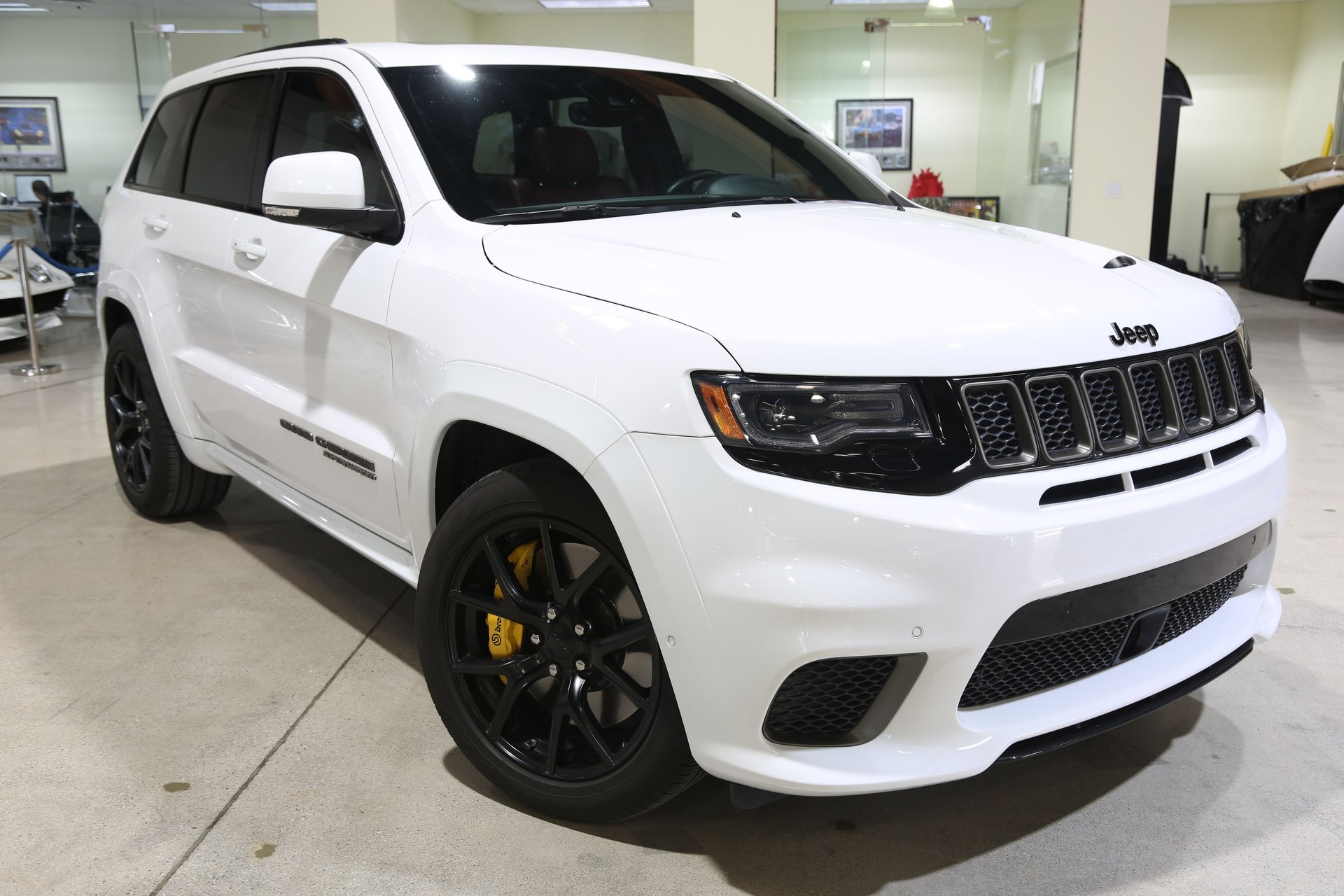
The performance focus extends to the braking system, which features massive 15.75-inch front rotors with six-piston Brembo calipers capable of bringing the 5,363-pound SUV from 60 mph to a stop in just 114 feet.
The adaptive Bilstein dampers and stiffer springs lower the ride height compared to standard Grand Cherokee models, reducing body roll and improving high-speed stability.
All this performance comes with a predictable penalty at the pump. The EPA rates the Trackhawk at just 11 mpg city and 17 mpg highway, making it one of the least efficient vehicles in its class. During spirited driving or track use, real-world fuel economy often drops to single digits.
The 6.2-liter supercharged V8 doesn’t employ cylinder deactivation or start-stop technology it’s engineered purely for performance without compromise.
Inside, the Trackhawk offers premium accommodations with leather and suede upholstery, carbon fiber trim, and a 200-mph speedometer that hints at the vehicle’s capabilities. The 8.4-inch Uconnect touchscreen includes specific performance pages that display real-time horsepower, torque, and g-force metrics.
With a starting price approaching $90,000, the Trackhawk costs nearly twice as much as a base Grand Cherokee. However, for buyers seeking supercar acceleration in a practical SUV package with genuine all-weather capability, the Trackhawk’s combination of extreme performance and everyday usability creates a compelling if environmentally unfriendly proposition that few competitors can match.
4. Mercedes-AMG G63
The Mercedes-AMG G63 represents perhaps the most unapologetic rejection of efficiency concerns in the luxury SUV segment. This hand-built German performance machine combines military-grade off-road capability with supercar-level straight-line acceleration, all wrapped in an iconic boxy silhouette that has remained largely unchanged for over four decades.
The G63’s approach to all-wheel drive is fundamentally different from efficiency-focused systems it employs three fully locking differentials (front, center, and rear) and a genuine low-range transfer case designed to conquer extreme terrain rather than maximize fuel economy.
At the heart of the G63 beats a hand-assembled 4.0-liter twin-turbocharged V8 engine producing 577 horsepower and an earth-moving 627 lb-ft of torque.
This enormous power output, channeled through a sophisticated 9-speed automatic transmission, allows the 5,845-pound SUV to accelerate from 0-60 mph in just 4.5 seconds a physics-defying feat given the vehicle’s brick-like aerodynamics and tremendous weight.

The side-exit exhaust system produces a thunderous soundtrack that announces the G63’s performance credentials before it even comes into view. The consequence of this performance-above-all approach is predictably dismal fuel economy.
The EPA rates the G63 at just 13 mpg city and 16 mpg highway, figures that can drop significantly during spirited driving or off-road adventures.
The vehicle incorporates cylinder deactivation technology that can shut down four cylinders under light loads, but this technology struggles to meaningfully improve efficiency given the G63’s weight, aerodynamic challenges, and performance-oriented gearing.
The G63’s interior presents a striking contrast to its utilitarian exterior, featuring hand-stitched Nappa leather upholstery, carbon fiber or wood trim options, and dual 12.3-inch digital displays.
Modern driver assistance features and the latest MBUX infotainment system create a thoroughly contemporary luxury experience despite the vehicle’s decidedly old-school construction and capabilities.
With a starting price exceeding $160,000, the G63 attracts a clientele for whom fuel economy concerns are largely irrelevant.
Its combination of unstoppable off-road capability, prestigious brand heritage, and supercar-rivaling acceleration creates a unique value proposition for wealthy buyers seeking an SUV that makes a powerful statement while refusing to blend in with the increasingly homogeneous luxury SUV world.
The G63’s flagrant disregard for efficiency reflects its position as a status symbol that celebrates excess rather than restraint a characteristic that actually enhances its appeal to its target demographic.
5. Bentley Bentayga Speed
The Bentley Bentayga Speed represents the pinnacle of luxury performance SUVs, offering supercar acceleration and bespoke craftsmanship in a package that utterly dismisses concerns about fuel efficiency.
At the heart of this British tour de force lies a monumental 6.0-liter twin-turbocharged W12 engine producing 626 horsepower and 664 lb-ft of torque sufficient to propel the 5,500-pound luxury SUV from 0-60 mph in just 3.8 seconds and on to a maximum speed of 190 mph, making it one of the fastest SUVs ever produced.
The Bentayga Speed’s all-wheel drive system is engineered primarily to harness the W12’s tremendous power output rather than to maximize efficiency.
The sophisticated system can vary torque distribution between the front and rear axles, with up to 85 percent of power directed to the rear wheels in Sport mode for more dynamic handling characteristics.
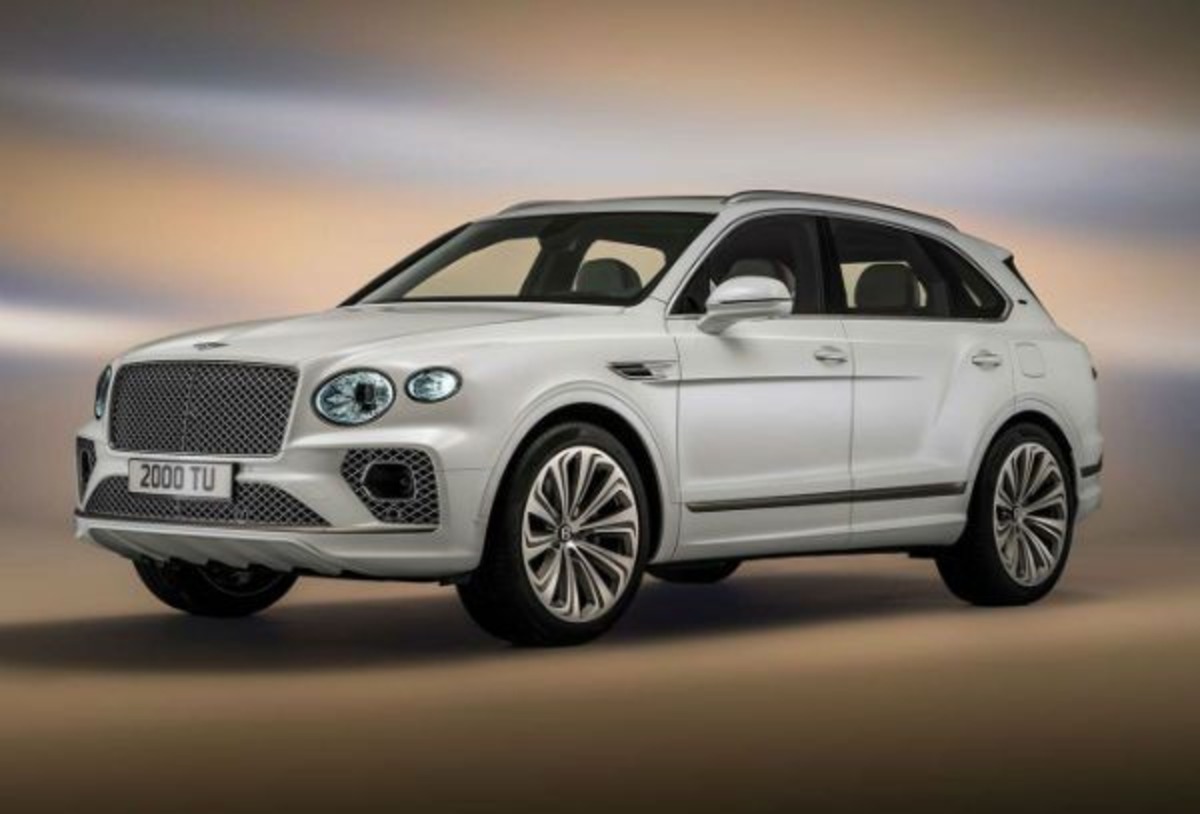
The Bentley Dynamic Ride system employs active anti-roll bars that use a 48-volt electrical system to counteract body roll during cornering, keeping the substantial SUV remarkably flat and composed during aggressive driving maneuvers.
Fuel economy is predictably extravagant, with EPA ratings of just 12 mpg city and 17 mpg highway. These figures represent the inevitable consequence of moving over two and a half tons of ultra-luxury materials and technology at supercar velocities.
While the engine incorporates cylinder deactivation technology that can operate as a six-cylinder under light loads, the Bentayga Speed’s performance-oriented calibration means that any attempt at economical driving is quickly abandoned when the driver explores even a fraction of the vehicle’s capabilities.
The interior showcases Bentley’s unparalleled craftsmanship, with each vehicle requiring over 130 hours of hand assembly. Up to seven hides of carefully selected leather upholster the cabin, complemented by genuine wood veneers, knurled metal controls, and available Mulliner custom details that can be tailored to the owner’s precise specifications.
The Bentayga Speed offers four, five, or seven-seat configurations, with the four-seat option featuring airline-style reclining rear seats with massage functionality.
With a starting price approaching $250,000 and custom builds easily exceeding $300,000, the Bentayga Speed caters to an ultra-wealthy clientele for whom fuel costs are entirely inconsequential.
Its combination of handcrafted luxury, supercar performance, and genuine all-terrain capability creates a unique proposition in the market.
For its target demographic, the Bentayga Speed’s extravagant fuel consumption isn’t viewed as a drawback but rather as a natural consequence of its uncompromising approach to luxury performance, an approach that prioritizes superlative experiences over practical considerations.
Also Read: 5 Cars That Make Great Uber Vehicles and 5 That Fall Apart in a Year

